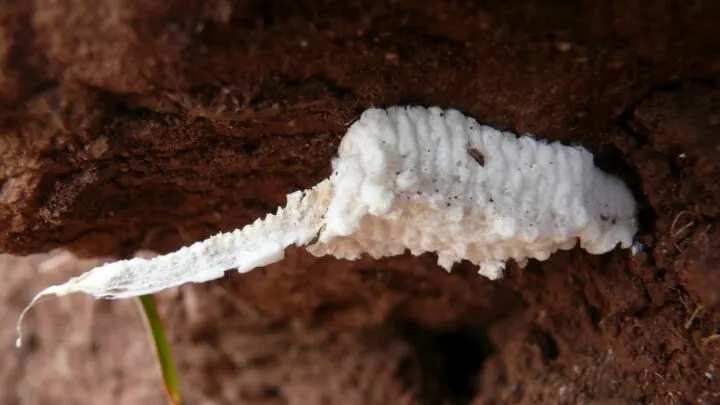Plants are the perfect addition to any garden or house and can turn an area that was once drab and lifeless into a colorful paradise.
Unfortunately, being a plant parent does still have its downsides, as there isn’t a single plant that is immune to diseases or pests.
Everyone will at some point experience an issue with a plant, so it is handy to know how to identify the problem and what to do about it.
Bug infestations can particularly be troublesome, but with the right advice and proper care, it is a matter that can be easily resolved.
Read on to find out what to do if you find tiny white bugs in your plant’s soil.
Table of Contents
Little White Bugs in Soil – Identification
Causes Why Tiny White Bugs Live in Soil
How to Get Rid of Tiny White Bugs in Houseplant Soil
Preventing Tiny White Bug Infestations
Tiny Bugs That Look Like Specks of Dirt
Tiny White Bugs That Look Like Dust
Fast-moving White Bugs in Soil
Tiny White Bugs in Soil
If you have noticed tiny white bugs in your soil, it could be a result of a springtail, mealybug, or soil mite infestation. These pests live off of your plant and the debris in the soil, but can be easily removed by using pesticides or by simply repotting your plant into clean, fresh compost.
Little White Bugs in Soil — Identification
Springtails
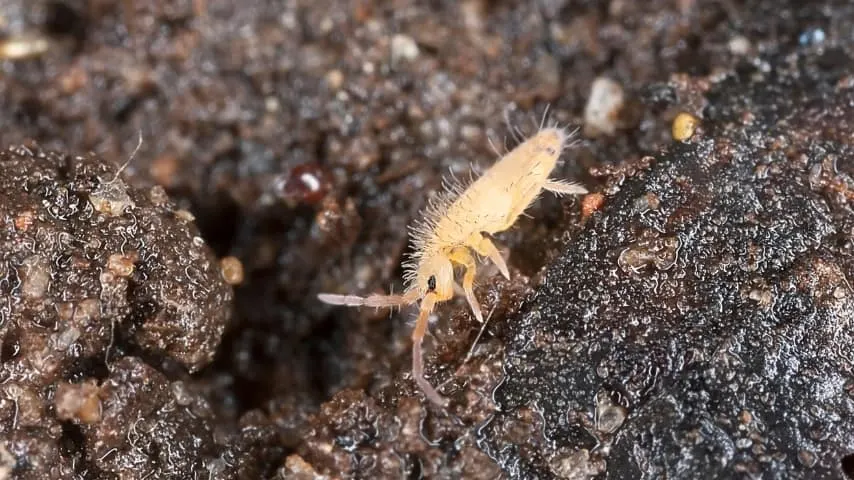
Springtails are aptly named for their fork-like tails, and their ability to jump up to 10 times their height.
They come in a variety of colors but usually take the form of a light grey or yellow.
They are very fast-breeding, often leaving your soil riddled if left unnoticed.
However, they won’t actually cause any harm to your plant. They live off of mold and dead plant debris and don’t attack the plant or its roots at all.
They thrive and breed in moist environments, which is why the soil of your plant is often perfect for them.
Although these pests aren’t necessarily problem-free, especially if your infested plant is a houseplant.
When the springtail’s environment becomes dry and no longer holds the moisture they need, they will quickly seek out a new location that fits their needs.
This means that they could decide to take up a new home in parts of your home, such as in damp carpets or floorboards.
Mealybugs
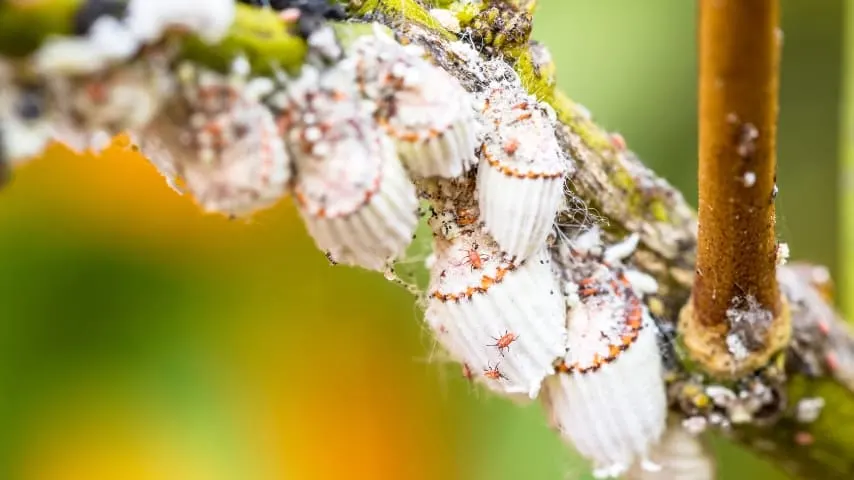
Mealybugs are tiny and white and may look like pieces of lint that have been scattered in the soil.
Unlike springtails, mealybugs can hold an active threat to your plant. They feed off of nutrients, which they could eventually strip the soil of if left untreated.
This could lead to leaves wilting, flowers dropping, and any future growth becoming disrupted.
Mealybugs don’t however burrow or create nests in the soil. They prefer to live on the undersides of leaves, but choose to lay their eggs on the surface of the soil.
Soil mites
Soil mites are very tiny bugs that are barely even visible to the naked eye. They are around the size of a pinhead and may look like small moving dots in the soil.
They usually live on the top few inches of soil and are completely harmless to your plant. Soil mites are even thought to have benefits to soil, especially if found in compost heaps.
Soil mites help to break down algae and fungus, which can, in turn, which make the nutrients easier to be absorbed by the plants.
They can however become unsightly and create a mess, especially if they choose to invade a potted houseplant.
Causes why tiny white bugs live in the soil
Many different factors could have caused these pests to seek a home in the soil of your plant.
Most bugs are attracted to the moisture in the soil, as the more moisture the soil holds the more bacteria there will be for these bugs to feed off of.
Ensure that you are only watering your plant as and when it is needed, and that you are not overwatering it.
Overwatering leads to a variety of diseases, with root rot at the forefront, which will in turn make your plant weak and more susceptible to infestations.
It is also possible that the bugs could have already been residing in the soil when it was purchased.
How to Get Rid of Tiny White Bugs in Houseplant Soil
There are many ways to get rid of tiny white bugs in your soil. Which method works best for you mainly depends on which kind of bug(s) you are dealing with.
Let’s have a closer look now at what you can do to free your plants from these annoying bugs.
Using organic pesticides
There are several chemical pesticides available for purchase from plant nurseries and garden centers, but I wouldn’t suggest using these unless your bug infestation has reached extreme lengths.
A solution of Neem oil and dish soap is a gentle solution that works very well on plant pests. Mix 2 tablespoons of oil and liquid soap in a gallon of water, and spray it all over the plant and soil.
Repeat the process every week, and the bugs should soon begin to disappear.
You can also choose to switch out the Neem oil for other solutions, such as Hydrogen Peroxide or even standard vegetable oil.
Transplanting your plant
If your infestation has reached an extreme, and no other solutions seem to keep them away then you should think about repotting your plant.
Start by carefully removing your plant from its soil, and then use water to thoroughly wash the roots.
You can then place your plant into a completely sanitized pot with fresh soil.
Ensure that you work on transplanting away from any other plants. This will minimize the risk of the bugs spreading.
Top tip – Always take great care when handling the roots of a plant, as damaging them could put your plant at risk of shock.
Preventing tiny white bug infestations
Tiny white bugs can appear in the soil of any plant, no matter how healthy they are. There are some interventions that you can do to prevent bug infestations.
Removing any fallen leaves and flowers from the soil will prevent the appearance of insects. Tiny white bugs often feed off of plant debris, are all more attracted to plants they can use as a good source of food.
I would additionally suggest creating a regular schedule in which you check all of your plants for signs of pests.
Most bugs can be found living in the top few inches of soil, so you only need to push back a small amount of soil to inspect your plant.
Tiny bugs that look like specks of dirt
Here are some of the most common tiny bugs that look like specks of dirt: Springtails, aphids, scale or fungus gnats.
Springtails are slender wingless insects that are white, grey, brown, or black.
They only grow about 1/8th of an inch long, and they have a forked tail. Springtails love moisture and flock to damp soil.
You can usually get rid of Springtails by reducing the amount of moisture in your soil and by taking care not to overwater your plants.
Once you have correctly identified that the dust-like insects on your plant are springtails, you can read up on how to get rid of them.
If you are not dealing with a springtails infestation, your enemy might actually be aphids. Aphids come in a variety of colors, including white, yellow, and pink, among others.
You can see aphids without a microscope, because they gather together in colonies, often on the undersides of new leaves and around other fresh, young plant material.
You can be pretty sure you have aphids if you notice sooty molds growing on your plants’ leaves and stems and on the top of their soil.
If you’re sure aphids are the source of a plant’s deteriorating health, check out this guide to aphid identification, control, and prevention.
However, these bugs that look like specks of dirt could also be scale.
Symptoms of scales include yellowing leaves, round brown markings, and stunted growth. As for what they look like?
They have small, slightly waxy, rounded bodies, and they attach themselves to plant stems and the undersides of leaves.
If you’re sure scale is the source of your problems, read up on the best hacks for getting rid of brown scale.
Last but not least, the culprit could also be fungus gnats. Gnats can look like little whizzing specks of dirt.
Despite being winged, fungus gnats are not particularly gifted at flying. They therefore tend to hang around at the base of plants, close to the soil, where they live.
Getting rid of fungus gnats is doable, so don’t despair if you realize that the bugs that look like specks of dirt on your plants are gnats.
Tiny white bugs that look like dust
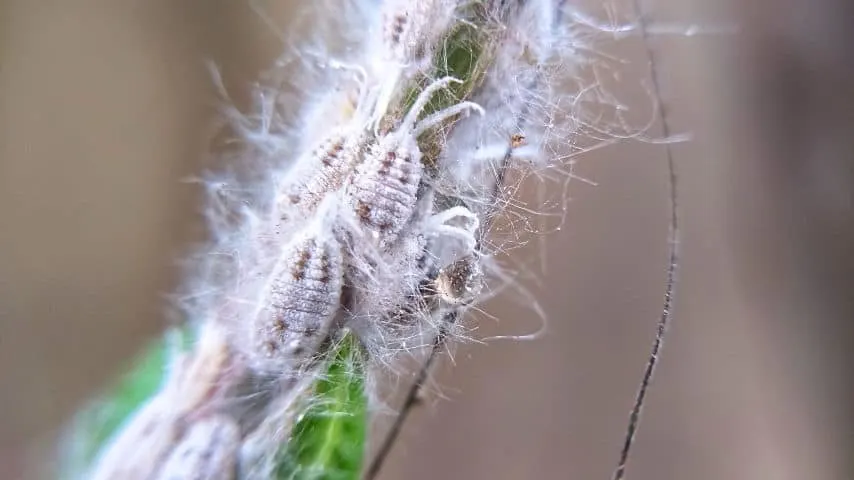
The tiny white bugs that look like dust on your houseplant or in your garden are most likely spider mites or mealybugs.
If you notice lint- or dust-like dots on your soil, try not to panic. As long as you correctly identify the problem early enough, you should be able to prevent serious damage to your greenery.
Here is a list of the most common dust-like bugs that take up residence in plants.
Spider mites are so tiny that you might just think a colony of mites is an accumulation of dust. They have tiny, one-piece bodies and eight legs. They have two telltale dark spots on their backs, and they leave delicate webbing around the stems and underneath the leaves of plants.
Some spider mite varieties are more damaging than others and can drive a plant’s leaves to wilt, dry up, and lose color.
However, even the tamer varieties of spider mite can cause most plants distress and even be lethal to certain kinds of vegetation.
One common sign of spider mites is that a plant leaves develop smatterings of yellow dots the size of pin pricks.
Unlike many of the other pests in this list, spider mites love dry conditions. To reduce your risk of getting spider mites, keep soil gently moist and don’t let it dry out too much between waterings.
To solve your problem and get rid of these tiny bugs that look like dust, look into what kills spider mites and take action without delay.
Mealybugs have a grey, dust-colored exterior. They live in clusters and prefer to settle in the more difficult-to-reach areas of a plant (think the place where a leaf meets a stalk, the underside of a bud, between climbing vines and trees, etc.).
Mealybugs are sap-sucking pests, and different varieties of this species live on all levels of plants. There are some that prefer root systems and others that thrive on the top-most leaves.
The sap-sucking process results in mealybugs excreting a sugary substance onto the leaves and stems of the plants they inhabit. Sooty, black mold grows on this sugary excretion and is a clear sign of mealybugs.
Other symptoms of a mealybug infestation include miniature orange egg deposits covered by a translucent, waxy webbing. If you notice leaf drop, this is also a potential sign that your plant has a mealybug problem.
Once you’ve narrowed it down and come to the conclusion that the dust-like creatures on your plant are mealybugs, you can look into the best ways to get rid of mealybugs.
Fast-moving white bugs in soil
If you notice fast-moving white bugs in the soil around your garden plants or houseplants, they are thrips or whiteflies.
Don’t immediately assume that you’ve been a bad plant parent just because your household or outdoor greenery has become host to an insect population.
If you’re wondering where houseplants get bugs from, the answer is that they can come from innumerable sources. Even the most diligent houseplant owner will have to deal with creepy-crawlies at some point or other.
Thrips are a particularly busy houseplant pest. Basically, they move around quickly and don’t seem to need much rest.
If there are white bugs moving around rapidly in the soil of your houseplant, there is a good chance you are looking at the yellow and grey variety of thrips, which can appear white against dark soil.
To confirm whether you have thrips, look out for slender, winged, pale-yellow insects. Even the largest thrips never grow beyond a quarter of an inch in size, so keep your eyes peeled when checking your plant for these creatures.
Unfortunately, thrips can be pretty damaging to the plant life they inhabit. Like many other plant-dwelling critters, they suck sap, which often results in pale, lifeless leaves that subsequently drop.
Badly affected plants may start to distort in shape.
However, the worst thing about thrips is not the sap they suck, it is the viruses they carry that can be transmitted to plants.
If left untreated, a thrip-infested plant may die.
To treat your thrips-infested houseplant, make sure to read our article: Thrips Damage: Do This!
If you notice fast-moving white bugs flying around the soil of your houseplant, they may well be whiteflies.
Whiteflies live on the undersides of leaves, but they fly off the green parts of a plant quickly and are often seen resting on the soil beneath plants.
Are whiteflies damaging for plants? Unfortunately, these sapsuckers can wreak serious havoc on plants. These white bugs feed on plant juices, which causes distress to the affected plant.
Plants with whitefly infestations lose their strength and often begin to turn yellow and dry out. In severe cases, a whitefly infestation can be fatal for a plant.
To get rid of whiteflies, treat your plant with a soap or alcohol-based solution, or purchase a biodegradable, less-toxic insecticide.
Tiny white bugs that jump
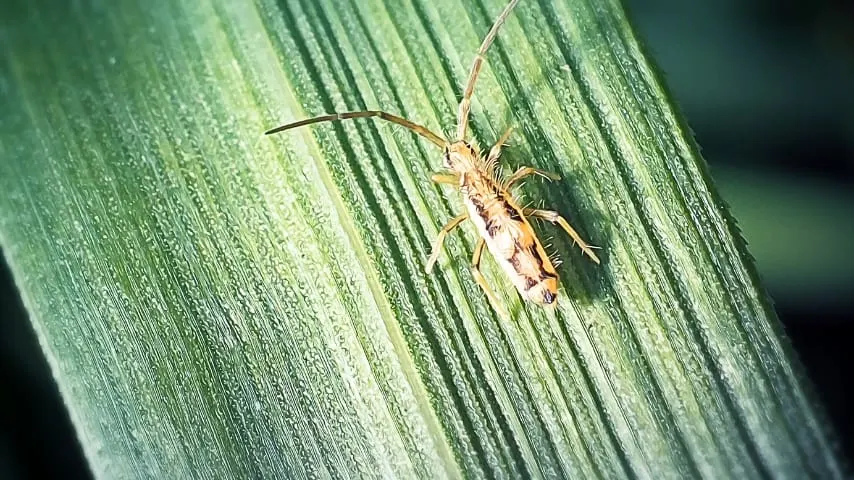
If you spot tiny white bugs in your houseplants that jump, chances are that you are dealing with Springtails.
If there are white bugs in the soil of your indoor or garden plant that are hopping about like magic beans, you are hosting springtails.
Springtails are thin, wingless insects that only grow to a maximum of less than a quarter inch long. They have telltale antennae, six legs, and forked tails that give them the ability hop impressively high.
To get rid of these jumping pests, you should allow your soil to dry out. Follow this up by treating your compost using a biodegradable soil drench.
Another helpful tip for ridding yourself of springtails is to use tape traps, which are usually used for eliminating fungus gnats.
Cut up these yellow fly traps into strips and place them over the surface of your houseplant or garden soil. Change the traps regularly.
How damaging are springtails? The good news is that, of all the white pests that could be inhabiting your plant, springtails are one of the most harmless.
This is because, unlike sapsuckers, they primarily feast on decomposing plant matter.
As a result, their impact on the plants they live in rent-free tends to be minimal. However, they are unsightly and proper plant care practice demands that you do your best to get rid of them.
Tiny white bugs at the bottom of the plant pot
Tiny white bugs at the bottom of a plant pot are usually soil mites or mealybugs.
Fortunately, soil mites are harmless for plants and can even help revitalize soil.
Soil mites make a point of avoiding healthy plant matter, which is great news for anyone who has just discovered them living in their houseplant pot.
Despite their benefits, however, they aren’t particularly attractive. If the mites keep producing, a plant pot that is playing host to them will be crawling, top-to-bottom.
The best thing to do to get rid of soil mites is to remove any rotting matter from your plant pot. This means repotting it.
If you’re wondering how to re-pot a houseplant, you need look no further. The excellent guide linked in the previous sentence will tell you all you need to know.
Mealybugs are tiny, white, fuzzy creatures like to stick to the undersides of leaves and to wedge themselves into any nook and cranny they can find. This includes on the underside of plant pots.
Are mealybugs harmful? Unfortunately, yes.
While you may not want to hear this, one of the best ways to get rid of mealybugs is to pick them off with your hands and dispose of them appropriately.
If you aren’t really into this, or if you’re looking for a hybrid solution, you can spray your soil and houseplant with a diluted methylated spirit. Mix a gallon of water with 15ml of spirit.
Pour the solution into the soil around your plant and spray affected plant leaves. After spraying, wait a few minutes and then wipe your plant down gently with a cloth and warm water.
White insects in soil
The white insects in the soil of a garden or houseplant pot are most likely mealybugs, spider mites, soil mites, springtails, or whiteflies.
Unfortunately, there is no one-stop solution to rid your soil of insects, because eliminating each of these critter varieties requires a different approach.
That said, the first step is to identify what the small white bugs in your soil are. Once you have done this, you’ll need to look into the specific treatment appropriate for each of these bugs.
As a rule, pick mealybugs off manually and get rid immediately. You can also spray the affected plant with an isopropyl alcohol solution.
You can also use 25 percent rubbing-alcohol solution to rid your plants of spider mites.
Spray your plant and its soil. Leave for five minutes, before wiping off the solution using a warm, damp towel. Repeat the process every other day until all signs of spider-mite life have disappeared.
To eliminate soil mites, you will need to re-pot your plant in fresh compost.
Sprinkle some cinnamon on the new soil and rub a neem oil-mixture into the fresh compost for a natural solution to this pesky (though ultimately harmless) problem.
To get rid of springtails, dry out your soil and treat it with a non-toxic soil drench.
Getting rid of whiteflies is best achieved with a homemade soap solution.
Mix one part dishwashing liquid with ten parts water. Pour the resulting solution into the soil of your plant. You’ll also want to spray or massage it onto the leaves of the affected plant.
Frequently Asked Questions about Tiny White Bugs in Soil
How long will it take for my plant to recover from tiny white bugs in the soil?
Once the tiny white bugs are killed and removed, you should see almost instant signs of recovery.
Will using mulch attract tiny white bugs?
Whether or not you use mulch will not make a difference. You should be sure not to over-mulch your plant, as this will the soil too moist and could result in a bug infestation.

Daniel has been a plant enthusiast for over 20 years. He owns hundreds of houseplants and prepares for the chili growing seasons yearly with great anticipation. His favorite plants are plant species in the Araceae family, such as Monstera, Philodendron, and Anthurium. He also loves gardening and is growing hot peppers, tomatoes, and many more vegetables.

